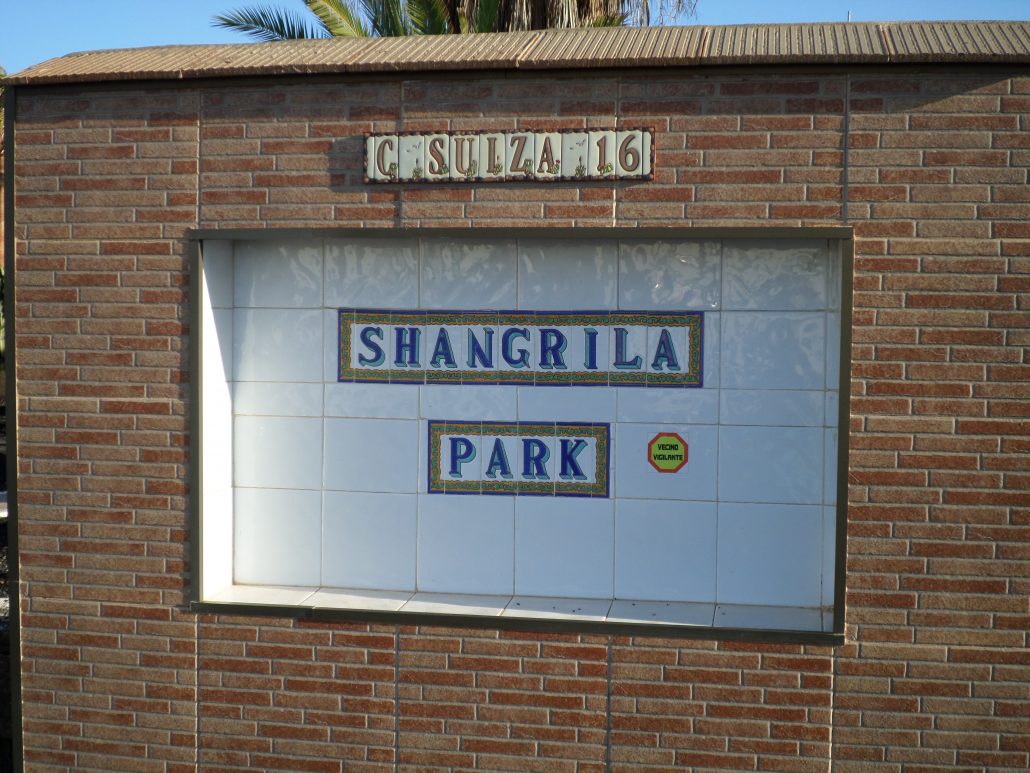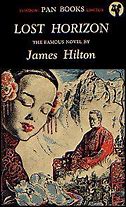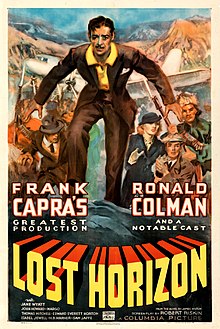OVER A LOST HORIZON ON LANZAROTE
OVER A LOST HORIZON ON LANZAROTE
by Norman Warwick

I have followed, with my wife Dee, a tangle of Sidetracks & Detours that I now think were inexorably drawing me here, to Shangri-la, on Lanzarote, where we now live. That phrase, the lost horizon, has been as important to me throughout my life as the phrase, the lost highway has always been to country singers, or as the yellow brick road was to to Dorothy, or the long and winding road to Paul McCartney. Having said all that, I´m not sure I can articulate, even now, quite what the lost horizon means to me: I can´t point it out to you. I do know, though, with the same certainty as held by those who believe in a God that I can step over that lost horizon in to Shangri La. In fact, I have already taken that step, some five years and I really do live in Shangri La (or Paradise or Utopia or Heaven as some call it). I was warned, through books and on films and in songs, that there would be a price to pay for stepping over the lost horizon, but come follow your art as we seek the truth.

The book, Lost Horizon, a 1933 novel by English writer James Hilton was turned into a film, also called Lost Horizon, in 1937 by director Frank Capra. Both the book and the film are perhaps best remembered as the origin of Shangri-La, a fictional utopian monastic retreat high in the mountains of Tibet. The film held me entranced when I saw it as a kid of ten or eleven. I had no idea, then, that I was watching a film that was in some ways, all about liminalities. In fact I didn´t know, then, what a liminality, (the space between) was as I don´t think I ever came across the term until attending university to read English Literature And Language as a so-called mature student at the age of fifty.
Sitting, with my dad, watching the Capra film shown in black and white on tv is a vision as clear to me today in the third decade of the twenty first century as it was in the mid nineteen sixties when I first saw the film. However, as a young kid I was so blissfully ignorant of al this that I didn´t even realise that in watching the film and questioning its attitudes to action and consequence I was perhaps undertaking my own earliest rite of passage.

The story told in the Capra´s film remains pretty faithful to Hilton´s novel which I read as soon as I saw it referenced in the credits on the telly. The tale is of Hugh Conway, a veteran member of the British diplomatic service, who finds inner peace, love and a sense of purpose in Shangri-La, (and I know how he felt) whose inhabitants enjoy unheard-of longevity.
The prologue and epilogue are narrated by a neurologist. This neurologist and a novelist friend, Rutherford, are given dinner at Tempelhof, Berlin, by their old school-friend Wyland, a secretary at the British embassy. A chance remark by a passing airman brings up the topic of Hugh Conway, a British consul in Afghanistan, who disappeared under odd circumstances. Later in the evening, Rutherford reveals to the neurologist that, after the disappearance, he discovered Conway in a French mission hospital in Chung-Kiang (probably Chongqing), China, suffering from amnesia. Conway recovered his memory, told Rutherford his story (which Rutherford recorded in a manuscript), and then slipped away again.
Rutherford gives the neurologist his manuscript, which becomes the heart of the novel.
In May 1931, during the British Raj in India, the 80 white residents of Baskul are being evacuated to Peshawar due to revolution. In the aeroplane of the Maharajah of Chandrapore are: Conway, the British consul, aged 37; Mallinson, his young vice-consul; an American, Barnard; and a British missionary, Miss Brinklow. The plane is hijacked and flown instead over the mountains to Tibet. After a crash landing, the pilot dies, but not before telling the four (in Chinese, which only Conway speaks) to seek shelter at the nearby lamasery of Shangri-La.
It´s location is unclear, but Conway believes that, before crashing, the plane had ´progressed far beyond the western range of the Himalayas towards the less known heights of the Kuen-Lun.´
The four survivors are taken there by a party of rescuers, who had found the lying in the snow, directed by Chang, a postulant at the lamasery who speaks English. The pages in the book, describing the party trudging up the dangerous mountain side through a an incredible blizzard are even more vivid when shown on screen-
The lamasery has modern conveniences, like central heating, bathtubs from Akron, Ohio, a large library, a grand piano, a harpsichord, and food from the fertile valley below. Towering above is Karakal, literally translated as Blue Moon, a mountain more than 28,000 feet high. Mallinson is keen to hire porters and leave, but Chang politely puts him off. The others eventually decide they are content to stay: Miss Brinklow because she wants to teach the people a sense of sin; Barnard because he is really Chalmers Bryant (wanted by the police for stock fraud) and because he is keen to develop the gold mines in the valley; and Conway because the contemplative scholarly life suits him.
A seemingly young Manchu woman, Lo-Tsen, is another postulant at the lamasery. She does not speak English, but plays the harpsichord. Mallinson falls in love with her, as does Conway, though less passionately. Conway is given an audience with the High Lama, an unheard-of honour. He learns that the lamasery was constructed in its present form by a Catholic monk named Perrault from Luxembourg, in the early eighteenth century. The lamasery has since then been joined by others who have found their way into the valley. After arriving, their aging slows but if they then leave the valley, they age quickly and die. Conway guesses correctly that the High Lama is Perrault, now 250 years old.
In a later audience, the High Lama reveals that he is finally dying, and that he wants Conway to lead the lamasery. The High Lama then dies. Conway contemplates the events.
Hours after the High Lama dies, Conway is outside still pondering the events while in the moonlight. Mallinson then grabs him by the arm and tells Conway he has arranged to leave the valley with porters and Lo-Tsen. Barnard and Brinklow have decided to stay. The porters and Lo-Tsen are waiting for him five kilometers outside the valley, but he is fearful of crossing the dangerous route alone, so he convinces Conway to go along and assist him. Conway is caught, divided in that ´liminality´ or space, between the two worlds. Ultimately, because of his love for the boy, he decides to join Mallinson. This ends Rutherford’s manuscript.
The last time Rutherford saw Conway, it appeared he was preparing to make his way back to Shangri-La. Rutherford completes his account by telling the neurologist that he attempted to track Conway and verify some of his claims of Shangri-La. He found the Chung-Kiang doctor who had treated Conway. The doctor said Conway had been brought in by a Chinese woman, who was ill and died soon after. She was old, the doctor had told Rutherford, That he described her as ´the most old of anyone I have ever seen,´ implied that it was Lo-Tsen, aged drastically by her departure from Shangri-La. The narrator wonders whether Conway can find his way back to his lost paradise.

The book, published in 1933, caught the notice of the public only after a subsequent, very different novel by Hilton, Goodbye, Mr. Chips was published in 1934. It was on the back of the author´s new found popularity that Lost Horizon became a huge popular success and in 1939 was published in paperback form, as Pocket Book #1. Because of its number-one position in what became a very long list of pocket editions, Lost Horizon is often mistakenly called the first American paperback book, when in fact paperbacks had been around since the mid-1800s. What made Pocket Book #1 of revolutionary importance was that it was the first “ass-market paperback; mass market paperbacks allowed people of modest means not only to own books they otherwise could not afford, but also to slip the paperback into their pocket for casual reading on the go, hence the name Pocket Book.
By the 1960s, Pocket Books alone, over the course of more than 40 printings, had sold several million copies of Lost Horizon, helping to make it one of the most popular novels of the 20th Century.

United States President Franklin D. Roosevelt named the Presidential hideaway in Maryland after Shangri-La. (It has since been renamed Camp David.) In 1942, to ensure the safety of returning U.S. forces, Roosevelt answered a reporter’s question about the origin of the Doolittle Raid by saying it had been launched from Shangri-La, a revelation that, if true, the hideaway had perhaps been named without any real understanding of what the ethos of Shangri La really meant !
The true details of the raid were revealed to the public a year later. This inspired the naming of the Essex Class Aircraft Carrier USS Shangri-La (CV-38), commissioned in 1944.
Not only did Lost Horizon, the novel, inspire two film adaptations including, a musical version but there have also been stage productions of a musical based on the story and countless radio versions of the novel over the decades since it was first published.
These radio performances include a one-hour adaptation by James Hilton himself, with Barbara Burnham, broadcast on the BBC National Programme at 20:30 on 1 August 1935, with a cast that included Esme Percy as “the High Lama”, Ben Welden as “Barnard”, Barbara Couper as “Miss Brinklow”, Jon Swinley as “Conway” and Cathleen Cordell as “Lo Tsen”. The broadcast was aired again in January 1936, and again in 1939 and 1945.
Orson Welles directed and starred in an adaptation for the Campbell Playhouse, broadcast on December 3, 1939 with Sigrid Gurie.
Ronald Colman reprised his screen role of “Robert Conway” a number of times for radio, including on the Lux Radio Theatre (September 15, 1941), Academy Award (November 27, 1946) and Favourite Story (July 24, 1948).
Herbert Marshall played “Conway” in Hallmark Playhouse‘s adaptation, broadcast on December 30, 1948.
The NBC University Theatre broadcast an adaptation on September 10, 1950.
A 3-part serialization of the book by Malcolm Hulke and Paul Tabori was broadcast on the BBC Home Service 5 in 1966 featuring Gabriel Woolf as “Conway”, Alan Wheatley as “the High Lama”, Carleton Hobbs as “Chang” and Elizabeth Proud as “Lo-Tsen”. This adaptation was re-broadcast on BBC Radio 4‘s Sunday Play in 1969.

Derek Jacobi (right) starred as “Hugh Conway” and Alan Wheatley as “the High Lama” in a 3-part BBC Radio 4 Classic Serial adaptation dramatised by Barry Campbell. Originally broadcast in 1981, it was re-broadcast in 2010 on BBC Radio 7, and again in 2012, 2014 and 2016 and was re-broadcast as recently as December 2019 on BBC Radio 4 Extra.
Whilst radio and the novel have served each other well, we should not forget thatthebook has also been adapted for film three times: there was the original, directed by Capra in 1939, with its incredible images of those rescued from the crashed plane being led through a blizzard, up a high single file mountain crossing over a deep chasm into the apparent Heaven, and haven, that was Shangri´-La.
It was to be almost forty years before the musical version, directed by Charles Jarrott was made, that met with only a minor success, and there has since been a made-for-tv film, called Bridge Of Time that many reviewers felt was also based on Lost Horizon.
The book also even served as the basis for an unsuccessful 1956 Broadway musical, retitled as Shangri-La.
Lost Horizon is still available in paperback format and is now published by Summersdale Publishers Ltd [1], ISBN 978-1-84024-353-6 in the UK and by Harper Perennial, ISBN 978-0-06-059452-7 in the United States.
The term Shangri-La has entered the lexicon and is described in The Cambridge English Dictionary as an imaginary, beautiful place, often far away, where everything is pleasant and you can get everything you want:

The Oxford English Dictionary more properly attributes the phrase as a proper noun for a Tibetan utopia in James Hilton’s novel Lost Horizon (1933). The common noun is described as a place regarded as an earthly paradise, especially when involving a retreat from the pressures of modern civilization. The origin of the phrase is said to be from Shangri (an invented name) + Tibetan la ‘mountain pass’.
Most dictionaries describe the phrase in similar vocabulary but I find it interesting that no dictionary definitions I could find referenced the caveats, of compliance and aging and the drawbacks of leaving the place. I am not sure that I could ever consider as a Utopia any place I was actually afraid to leave.
In some ways that has been borne out by my experience since coming to live here in Shangri La, a community complex on the glorious island of Lanzarote where we can stroll on shaded coastal walkways and count the millions of sparkling diamonds, cast by the sun and rolling in on the tide. We have endless blue skies, constantly warm temperatures, swaying palm trees and glorious mountains and meadows bursting with colourful wildflower.
At the centre of this Shangri La is my house, the very kernel of Heaven, with its light and airy rooms, cacti garden, huge, flat roof with panoramic sea views, a lighthouse to keep watch over us, good neighbours, beautiful cats and the musical soundtrack of our lives. It is heaven this Shangri-la and none of us had ever wanted to leave,….until we were told we couldn´t ! When covid 19 locked us in, many of us felt we were trapped not in a heaven but in a hell. Knowing that the simple pleasures of this paradise were just outside my garden, un-gated and yet somehow locked down by decree and a coronavirus, I began to reconsider my notions of Shangri-la and was reminded vividly of James Hilton´s notions that Shangri La, forfeits all its perfection if we do not have the option to exit and re-enter as we please.
Things seemed to be returning towards the perfection we once enjoyed but the awareness that Shangri La can be opened and closed to us at the will of others has disturbed the paradigm of paradise. Covid 19 has shown us that even on Shangri la there is governance, and now, just when Boris Johnson announced only last week that he was opening the air corridor for the UK to Lanzarote, there is a press briefing in an hour´s time, Saturday 31st October, when Boris Johnson, like some Halloween horror is likely to announce that he is reneging on that promise and is instead putting his entire country into lockdown. That has massive repercussions here on our island that is so reliant on the tourist trade. Whilst we realise empty restaurants are preferable to full hospitals, a total UK lockdown again now would massively impact on the livelihoods of thousands of people who have behaved so diligently to keep down our own covid figures.
There will also be neighbours of ours here on Shangri La who won´t now be able to return here, having gone back to their UK homes for family or health reasons. What an eerie echo of the premise of James Hilton´s Lost Horizon premise. Fortunately, we have a committee elected to keep Utopia on track ! Epidemic, committee, rules, layouts, costs and ramifications are as relevant to Shangri La, it seems, as they were in my former life. Have I just been through another rite of passage, then, at the ripe old age of sixty eight?




Leave a Reply
Want to join the discussion?Feel free to contribute!